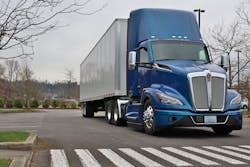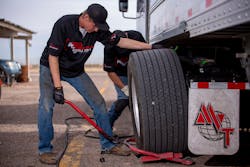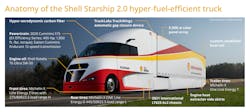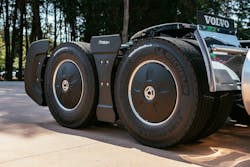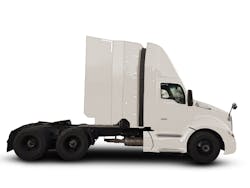Even though the trucking industry is always evolving, two things are always the same for a successful over-the-road fleet. First, those Class 8 tractor-trailers must get to where they’re going safely, on time, and with the least amount of energy necessary. And second, fleets must attempt to spend the least amount of money and time maintaining that equipment to consistently achieve those results. If there’s a third thing, it’s that neither No. 1 nor No. 2 are as easy to pull off as they sound. Government regulations, economic ebbs and flows, and an evaporating labor pool all threaten to dash even the best laid truck business plans. But with the tried-and-true philosophy of “working smarter; not harder,” or more specifically, emphasizing fuel efficiency in every facet of the fleet, a trucking company at least has a chance.
The North American Council for Freight Efficiency identified several areas that can impact fuel efficiency, releasing a vast library of confidence reports and guidance on crucial areas ranging from the powertrain and low-viscosity engine oils to low rolling resistance tires and aero kits. The 2019 Annual Fuel Study detailed how using a wide swath of available fuel-efficiency technologies affected the 21 participating fleets’ fuel costs. The 73,844 trucks involved “saved $895,318,953 in 2018 compared to the average trucks on the road,” according to the report. Collectively, these trucks averaged 7.27 mpg; the national average for the previous year was 5.98 mpg.
It’s a major reason OEMs have eschewed their classic tough-guy exterior look for sleeker bodies. Just look at Kenworth and Peterbilt trucks. The Paccar-owned truck makers both launched updated versions of their flagship OTR haulers in early 2021. With additions such as the updated Paccar integrated powertrain over the 2017 MX-13, larger air dams, and narrower hood, the Peterbilt Model 579 betters its predecessor’s fuel efficiency by 7%. For the T680 Next Gen, Kenworth added a new aero bumper and hood, lower fairing extensions, 28-inch side extenders (and more), which can lead to a 6% improvement in fuel economy over the classic T680.
Over at Mack Trucks, the Anthem Advanced Aerodynamics Package leverages the MP8HE/mDrive integrated powertrain, along with aero tweaks such as a bumper air dam and close out flanges, and adjustable cab fairing (to optimize airflow for various trailer heights), to reach 15-16% better fuel efficiency than older Anthems. Some trucks regularly hit nearly 11 mpg.
The big thing to realize is what happens on the road with the driver and what happens in the shop are inextricably linked. Trucking is a team sport, with drivers as the offense and technicians as the defense. A driver culture where aggressive behavior, such as excessive and undulating speeds are accepted, strains the finely tuned, sophisticated equipment, and creates extra work for the shop.
“If you’re burning less fuel, you are being gentler on the power plant, and it requires less maintenance,” explained Mike Roeth, executive director of NACFE. “If you’re not hitting the brakes and then accelerating, or making a lot of lane changes, all those kinds of things create better fuel economy, and you get a benefit in maintenance.”
The reverse is also true: NACFE’s 2016 confidence report on truck maintenance’s impact on fuel efficiency, in which 12 fleets were canvassed, revealed “fuel consumption improvements of 5 to 10% after the implementation of rigorous preventive maintenance practices.”
And those savings could be put to good use by reinvesting in new technology or talent to ensure better uptime.
“We believe it to this day that with fuel prices like we’re at now, it’s enough that it could help fund a fleet to have a better maintenance program, either by hiring another person, or by putting in place a good maintenance software system,” Roeth said.
Other benefits of maintaining fuel-efficiency related equipment the report mentioned included more uptime, higher resale value, better driver safety and satisfaction, and a reduction in CSA violations and fines.
Before the report, which is slated to have an update by the end of 2021, Roeth said many fleets dismissed the symbiotic relationship.
“No, they’re separate things—you fix things, you repair things, and you maintain things on a truck to keep the truck running,” Roeth recalled of the general sentiment.
“But a down truck is not efficient,” he added, “so the linkage between a good maintenance program and the mpg or the efficiency of the truck is important; people didn’t really get it until we started digging into it in that first report.”
The report singled out 10 specific areas to build a maintenance strategy around to key in on:
- Lubricants/Engine Oil
- Intake/Exhaust System and Diesel Particulate Filters
- Engine Cooling
- Air Compressors
- Wheel Alignment
- Tires
- Fuel Filter Systems
- Aerodynamic Devices
- Electrical Systems
- Air Conditioning
Combined, issues in these areas could impact 30 to 50% of fuel consumption, though the report notes that no truck would conceivably have problems with all of them at the same time. But the intent was to point out even minor problems on small components add up over time.
Roeth explained simple things like lubricating the fifth wheel can pay off: “If you’ve got a sticky fifth wheel, it might dogleg the tractor-trailer a little bit.” This would lead to a less aerodynamic profile and more tire wear.
And oftentimes it only take a little extra attention to preventive maintenance and inspections, from checking air filters and engine oil purity to the truck’s alignment.
“The more you maintain the truck and address issues, from rattles on aerodynamic devices, clogged diesel particulate filter or any other filter, or air leaks in the charge air cooler system, those things all lead to a little better fuel economy,” Roeth said.
And if the goals of the shop and operations side are aligned, the trucks should be better positioned to reach a clean bill of health and maximize fuel efficiency benefits.
But how to achieve ultimate fuel efficiency is easier said than done, as well. It is possible with a smart approach from the get-go, and remembering not to hit the brakes on monitoring a truck’s fuel efficiency after a year or two of service.
“The first thing is to start off on the right foot with the right equipment,” said Daryl Bear, lead engineer and COO of Mesilla Valley Transportation Solutions. “Spec’ing the most fuel-efficient vehicle, and having a strong maintenance team that’ll keep it up, that’s a winning package.”After all, what good is spec’ing the best engine or low rolling resistance tires if routinely clogged filters or underinflated tires negatively undo any positive gains?
“The maintenance team is really the group that has to deal with whatever the powers that be decided to put on the equipment,” Bear continued. “So having a strong maintenance team and good practices—and just maintenance people who care—makes a huge difference in the fleet, and really makes a huge difference in what you can adopt from a fuel economy perspective.”
Starting off right
For an aspirational look at what is possible, look no further than the Shell Starship 2.0 results, which NACFE assisted in validating. Fitted with the latest advances in engine oil, aerodynamics, powertrain, and more, the “hyper-fuel-efficient truck,” as Shell Lubricants called it, achieved a 10.8 mpg average while hauling 47,100 lbs. of artificial coral reef from San Diego to Jacksonville, Florida, this past summer. This was an improvement of 21% over the 2018 run of 8.94 mpg, and was due to upgrades in the chassis (from a 2015 International ProStar to 2021 LT) and powertrain (from prototype 2015 Cummins X15 to the mature 2020 X15 Efficiency Series), along with aerodynamic tweaks, such as adding the TruckLabs TruckWings automated tractor-trailer gap sealer.
Fleets aren’t in the position to spec carbon-fiber, bullet-shaped cabs, but most of the other equipment is available for OTR fleets. And when spec’ing a new truck, a cost-benefit analysis should be done. With LRR tires in particular, a fleet should consider not only rolling resistance, but durability. What works for one fleet might not be the best for another.
“Every fleet’s balance between efficiency and reliability is different,” Bear noted. “Some fleets will deal with some more maintenance issues if it means they’ll get half mile per gallon better fuel economy, but some other fleets’ timing is so critical, that they’d rather lose on fuel efficiency to make sure that the load is delivered.”
Mesilla Valley Transportation Solutions, a spinoff venture from Mesilla Valley Transportation, uses racecar testing methods to validate equipment such as aerodynamic kits and LRR tires for the manufacturers and trucking fleets interested in making large orders.
Bear said MVT leadership and the maintenance department are in regular communication before and after spec’ing to ensure what they thought was the right decision really was.
The fleet switched back to dual tires from singles even after being “a big proponent of wide base tires,” Bear said, noting this was due to “a combination of the fuel efficiency and duals getting a lot better and closing that gap.”
In general, reaching peak fuel efficiency requires constant research and validation.
“There are a lot of specs out there to improve fuel economy, but trucking fleets are really not aware of how good they are,” said Bear, stressing that the industry needs to educate itself on what gains can truly be made.
Those gains can be substantial just with some aero additions. Recently, both FlowBelow and Transtex touted the fuel efficiency scores their equipment received from MVTS. FlowBelow’s Tractor Aero Kit, which closes the gap between tractor wheel to reduce drag, came in at 2.13% better than the same truck without it, while its tractor and trailer wheel covers improved fuel efficiency by 0.93% and 0.81%, respectively.
FlowBelow’s devices are relatively easy to clean and remove for tire service, said Marcus Myers, vice president of maintenance at Gulf Relay. He did say a newer design on the Freightliner version necessitated also spec’ing air release fifth wheels for better accessibility. “Some drivers have had trouble reaching the release handle with the current design,” Myers said.
The Transtex Edge Elite Aero System, which comprises mudflaps, a few bolted-on flexible trailer skirts, and discrete aero fairings at the top and sides of the trailer backend, yielded a 1.2 mpg improvement, or a 10.49% gain.
Trailer skirts might be great at reducing drag, but if drivers are returning them damaged so often that they have become a major drag on the maintenance operations, then is it such a wise investment? Here, questions on durability should be answered before attaching them to hundreds or thousands of trailers.
The Transtex skirts are made of Nylon 66, so they will flex and return to their original shape upon less extreme impact.
Bear noted that trailer boat tails can create “headaches” for maintenance personnel. MVT factory installs Michelin’s Energy Guard aerodynamic solution because it provides fuel efficiency (10 gallons per 1,000 miles) while resisting damage. “There’s nothing hanging off the back of a trailer with the Michelin kit, so there’s just much less opportunity for damage,” Bear said. “And then there’s no driver interaction and then just no moving parts.”
Because of their skirt ruggedness, Myers said Gulf Relay is also going to adopt the Michelin solution on its next order of trailers. “They’re almost collapsible brackets that will pop back into place, so we’re going to give them a shot—they might put those headaches to rest.”
The numbers add up
A fleet, however, doesn’t need to look for homeruns with every spec. Bear said getting a fleet to achieve a 0.3 or 0.4% increase in fuel efficiency could be huge win: “When you do 150 million miles a year, it adds up pretty quick.” MVT’s logistics fleet has 1,500 trucks—if they all traveled 100,000 miles a year, they would reach that exorbitant number.
At the time of writing this, the U.S. national average diesel price was $3.30, so a 0.3% increase represents about a penny a gallon. Factoring for a 7-mpg fleet average, that equals $707,142 in savings over 150 million miles.
When spec’ing powertrains, along with weighing performance and efficiency benefits, a fleet must also decide what type of engine oil to use.
Switching from a 15W-40 to a 10W-30 grade will likely yield better fuel efficiency. “The thinner the oil, the easier it is to flow, the less input energy it takes for parts to move against each other,” said Karin Haumann, OEM technical manager with Shell Global Solutions. “The increased fuel economy comes from that.”
A fleet called Boaty’s Transport said it got 2% better fuel efficiency with Chevron Delo 400 ZFA 10W30 (FA-4), while also seeing wear and oxidation control benefits “The combination of engine protection and improved fuel efficiency is a real plus in helping us manage our costs in this competitive business,” Boaty’s owner Michael Boatwright said.
Another offering, Delo 600ADF, also reduces aftertreatment maintenance due to 0.4% ash content.
Consulting OEM standards is crucial, as not all engines are rated for the FA-4 standard, which can offer more fuel efficiency benefits than CK-4, but not backwards compatible like CK-4 is. Going from a 15W-40 to a CK-4 10W-30 offers a 2% improvement in fuel economy, and an FA-4 10W-30 while FA-4 can provide a 2.5% gain, Haumann explained.
“I’m not a fan of having multiple oils for different trucks, it just adds a lot of confusion,” said Paul Pettit, vice president of maintenance at Dart Transit. The Minneapolis-based fleet uses trucks from three different OEMs in its fleet of 1,100, and switched from 15W-40 to a 10W-30 (CK-4).
“We got everybody on the most efficient oil for the newer trucks that would still be compatible with the older trucks,” Pettit said.
Maintaining the efficiency
Now, the owner or president of a fleet might salivate over the potential slashing of percentage points off an annual fleet fuel bill, but as Bear noted, the true path to maximum fuel efficiency is the one that can be consistently maintained.
The first option is to entrust the dealer network with the heavy lifting.
Mack recently announced the Mack Premium Service Agreement for new trucks and those who have not hit their first service interval. The service places a keen focus on fuel efficiency and includes scheduled powertrain, aftertreatment, and axle maintenance, along with a 74-point inspection and oil analysis.
“It’s really to get you to stay on plan,” said Stu Russolli, Mack Trucks highway product manager. “Now you know you have all that paid for—are you not going to get the truck in? You don’t have an excuse.”
MVT uses Penske for maintenance, along with its own dedicated inspection group.
“They go bumper to bumper, and underneath as well,” Bear said. “So they’re checking, obviously, if anything’s broken, but otherwise, the tread depths, and of course, we’re looking at whether oil needs to be changed and things like that.”
When MVT handled everything internally, he said the company gave the maintenance team bonuses for meeting fuel efficiency goals.
Dart reviews fuel efficiency performance every other month or so, identifying potential issues and addressing them at the next PM interval, Pettit said. Dart then puts the focus on how drivers might be making it more difficult on the maintenance side by seeing if anyone is behaving beyond what is expected in terms of efficiency.
“We use our telematics to review them on a truck-by-truck basis versus looking at one specific make model year and seeing how that entire model year is looking,” Pettit said. “From there, we look at what kind of outliers we are having, and if that idle percentage is driving fuel economy down or anything like that and try to work towards educating drivers where we can on how to reduce idle.”
According to NACFE, a 10% annual reduction equals 1% in fuel economy, while the American Trucking Associations estimated that idling creates twice the wear and tear on the engine parts that driving does.
Gulf’s Myers also said his fleet looks at fuel efficiency-geared PMs every other month, but for certain items they “have to be proactive.”
“Fuel filters are really your biggest challenge,” Myers said. “We’ve battled some different issues with algae buildup.” They use Mack Virtual Technician with OneCall to diagnose fault codes, and also calibrated parameters to monitor idle time.
Myers’ final piece of advice on how to improve fuel efficiency through maintenance? “Find good drivers,” he concluded.

